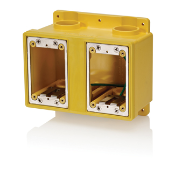680.12 and 680.14 Equipment Rooms and Pits. (Swimming Pools, Fountains, and Similar Installations) and 680.14 Corrosive Environment
Change Summary
- A new requirement for protection against a corrosive environment for electrical equipment installed in equipment rooms and pits was added at 680.12 and 680.14.
| NEC® Text |
|---|
|
680. Informational Note: Chemicals such as chlorine cause severe corrosive and deteriorating effects on electrical connections, equipment, and enclosures when stored and kept in the same vicinity. Adequate ventilation of indoor spaces such as equipment and storage rooms is addressed by ANSI/APSP-11, Standard for Water Quality in Public Pools and Spas, and can reduce the likelihood of the accumulation of corrosive vapors. 680.14 Corrosive Environment. Copyright© 2016 National Fire Protection Association |
Expert Analysis
When installing electrical equipment in a room or pit, it is important to make sure that proper drainage and corrosion protection is provided.
Quite a few places in Article 680 discuss things like metal conduits needing to be corrosion resistant and suitable for the location, but corrosion protection was not addressed in previous editions of the Code in Article 680 for electrical equipment in designated rooms or pits. This situation was rectified for the 2017 NEC with the revision of 680.12, which was 680.11 in the2014 NEC, and the creation of new 680.14. Code language was added at 680.12 and 680.14 requiring electrical equipment located in equipment rooms or pits or areas where pool sanitation chemicals are stored to be suitable for the environment in accordance with 300.6. A look at 300.6 reveals that “raceways, cable trays, cable bus, auxiliary gutters, cable armor, boxes, cable sheathing, cabinets, elbows, couplings, fittings, supports, and support hardware shall be of materials suitable for the environment in which they are to be installed.”
The new provisions at 680.14 identify areas where pool sanitation chemicals are stored, as well as areas with circulation pumps, automatic chlorinators, filters, open areas under decks adjacent to or abutting the pool structure, and similar locations as being considered to be a corrosive environment. The air in such areas is also considered to be laden with acid, chlorine, and bromine vapors, or any combination of acid, chlorine, or bromine vapors. This new section also requires wiring methods in these areas to be listed and identified for use in such areas.
This new corrosion-resistance requirement at 680.12 addresses the suitability of the equipment for these locations and will allow the to address these issues from a Code standpoint.
Leviton Wetguard® devices are designed for applications where electrical connections are exposed to wet and corrosive locations. They have IEC and NEMA watertight and dust-tight enclosure ratings and offer many significant advantages over competitive brands. A patented multi-point sealing system forms a barrier against dirt and moisture providing the ultimate protection that you should expect from a watertight device. The Wetguard® line features corrosion-resistant electroless nickel-coated brass blades, contacts, terminal screws and wiring clamps, and stainless steel assembly screws. They are resistant to water, acids, alkalies, and many automotive and industrial lubricants and solvents. The plug and connector husk is molded to a bondable nylon body, providing a device that withstands physical abuse as well. In addition, the patented compression nut strain relief system ensures the integrity of the electrical connection and watertight seal.















